Physical Address
304 North Cardinal St.
Dorchester Center, MA 02124
Physical Address
304 North Cardinal St.
Dorchester Center, MA 02124
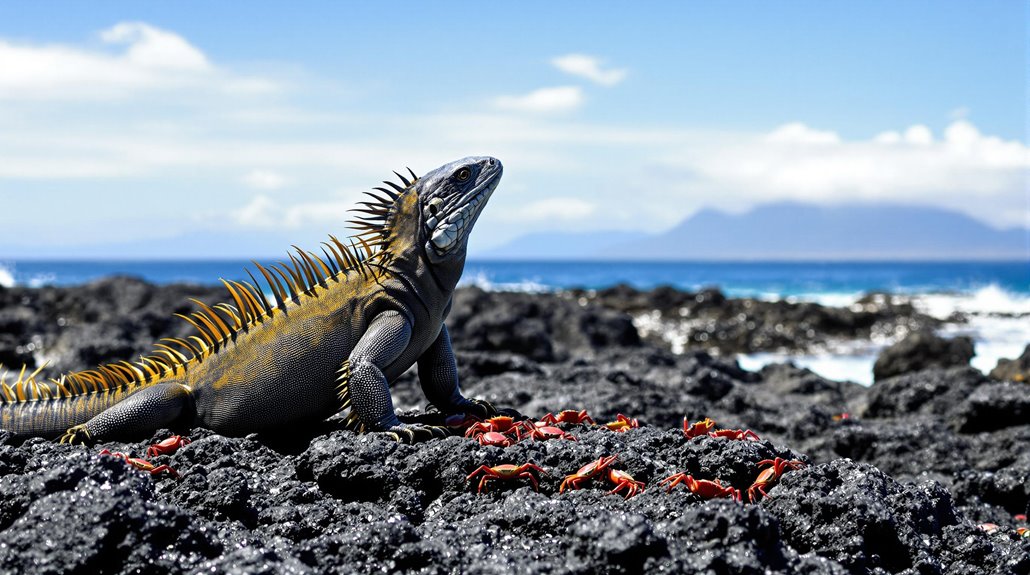
You'll discover a world where volcanic drama meets evolutionary wonder in the Galápagos Islands. From the moment you set foot on these remote Pacific outposts, your camera will capture nature's most compelling stories. Each island offers distinct landscapes and creatures that can't be found anywhere else on Earth. Whether you're drawn to marine iguanas basking on black lava rocks or blue-footed boobies performing their mating dance, these islands hold secrets that'll transform how you see our natural world.
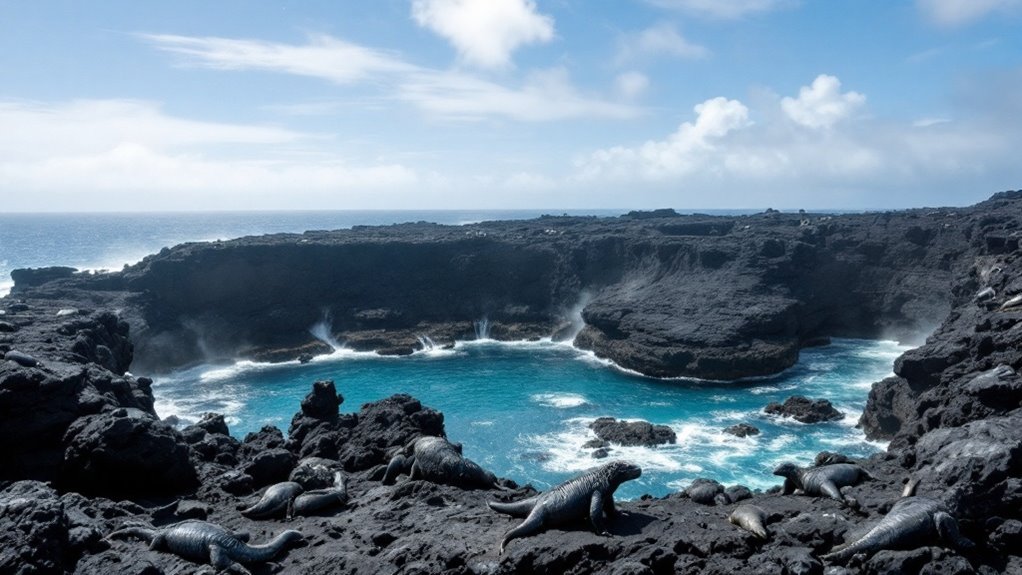
While most oceanic islands gradually erode away, the Galápagos Archipelago continues to grow through an ancient volcanic hotspot beneath the Nazca Plate.
You'll encounter over 21 volcanoes here, with 13 still active and regularly reshaping the landscape.
As you explore the islands, you'll notice how the archipelago ages from west to east. The western islands, like Fernandina, are the youngest at roughly 500,000 years old, while eastern islands such as Española have weathered about 5 million years of ocean spray.
Like a timeline etched in stone, the Galápagos tells its age from young western shores to ancient eastern islands.
Isabela, the largest island, showcases six massive shield volcanoes that merged together millions of years ago. These volcanic formations provide critical research opportunities for scientists studying Earth's geological processes.
Along the coastline, you'll discover dramatic cliffs and sea arches where volcanic layers meet the ocean, revealing the islands' fiery past through exposed rock formations.
As nutrient-rich currents converge around the Galápagos Islands, you'll witness one of Earth's most remarkable marine spectacles.
Along the shores, marine iguanas – the world's only seafaring lizards – dive up to 30 feet deep, grazing on algae for half an hour at a time.
At Gardner Bay, you'll spot playful sea lions darting through schools of tropical fish, while at Devil's Crown, reef sharks glide past lively coral formations.
The cold Cromwell Current creates a unique environment where you can watch Galápagos penguins – the northernmost colony in the world – swimming alongside tropical species.
In these protected waters, you'll encounter some of the 3,000+ marine species that call the islands home, including 86 fish species found nowhere else on Earth. The recent expansion announced at COP26 marine protection will help safeguard these unique creatures for generations to come.
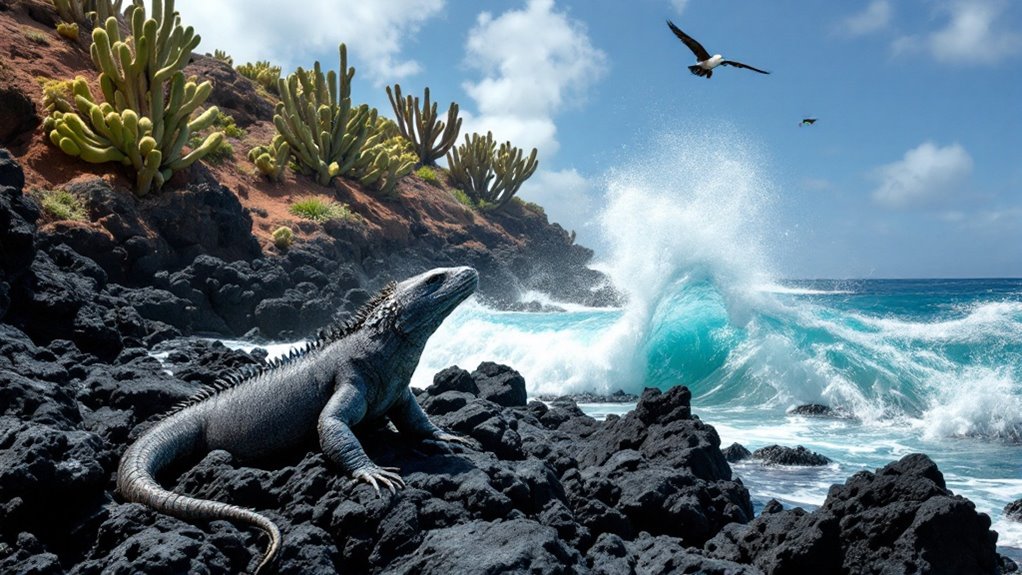
The rich marine biodiversity of the Galápagos tells only half the story.
On land, you'll discover yourself in Darwin's living laboratory, where evolution's greatest mysteries first came to light. As you explore, you'll encounter fearless creatures that haven't changed their behavior since Darwin's visit in 1835.
Watch giant tortoises lumber through their island homes, their distinctive shell shapes matching the local vegetation.
You'll spot Darwin's famous finches, whose varied beaks demonstrate natural selection in action. Marvel at the unique flightless cormorants and marine iguanas that showcase evolution's remarkable adaptability.
The islands' isolation, created by volcanic forces millions of years ago, has produced an unparalleled natural experiment. Here, across seven distinct habitat zones, species continue to adapt and evolve before your eyes. The archipelago rises dramatically from the ocean floor at the meeting point of the Nazca and Cocos tectonic plates.
Deep beneath the Pacific Ocean, volcanic forces created the Galápagos Islands over millions of years, forging a living laboratory of evolution.
You'll discover a dramatic landscape where tectonic plates meet, creating diverse habitats from wave-battered coastlines to misty highlands.
These unique geological features have shaped the archipelago's remarkable biodiversity:
As you explore these islands, you'll witness how volcanic origins, ocean currents, and climate patterns have created the perfect conditions for Darwin's natural laboratory, though human activity now threatens this delicate balance. Today, the island of Isla Isabela stands as the largest and youngest testament to these ongoing geological processes.
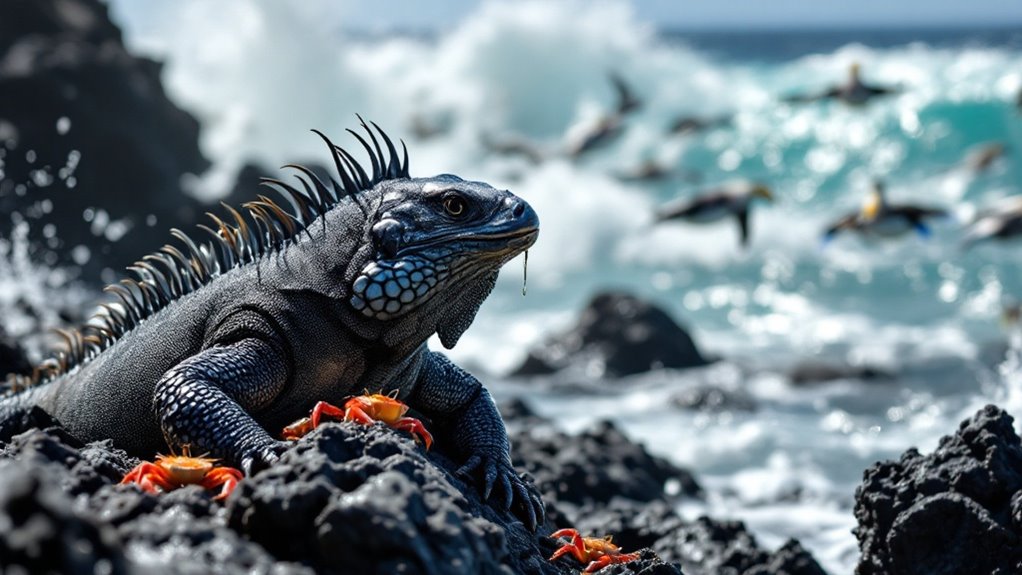
While Darwin's theory of evolution found its inspiration here, today's visitors to the Galápagos encounter an unparalleled display of fearless wildlife across the archipelago's diverse ecosystems.
You'll swim alongside playful sea lions and green sea turtles in crystal-clear waters, while schools of hammerhead sharks patrol the depths near Wolf and Darwin Islands. Look for the distinctive bulging eyes and ears of the elusive Galapagos fur seal resting in shaded rocky areas.
On land, you'll spot giant tortoises weighing up to 417 kg lumbering through the highlands and marine iguanas basking on black lava rocks before diving for algae.
The skies showcase an extraordinary array of birdlife, from blue-footed boobies performing their distinctive courtship dances to magnificent frigatebirds inflating their bright red throat pouches.
Even more remarkable is how close you can get to these creatures – they've evolved with minimal fear of humans, offering unprecedented wildlife viewing opportunities.
Beyond the remarkable wildlife encounters, stark geological contrasts shape the Galápagos landscape into a photographer's paradise.
You'll discover yourself shifting from pitch-black lava fields to pristine beaches within minutes, each offering distinct photo opportunities. Sullivan Bay's pahoehoe lava flows create mesmerizing patterns, while Rabida's iron-rich red sand beaches provide stunning foregrounds. The area's unique sea lion interactions add dynamic elements to beach photography.
The archipelago's most photogenic geological features include:
Nature's masterwork in stone – the Galápagos showcases Earth's most striking volcanic sculptures against pristine oceanic backdrops.
Whether you're capturing tidal pools at Puerto Egas or flamingos in coastal lagoons, you'll uncover endless compositions where volcanic forces meet pristine coastal environments.
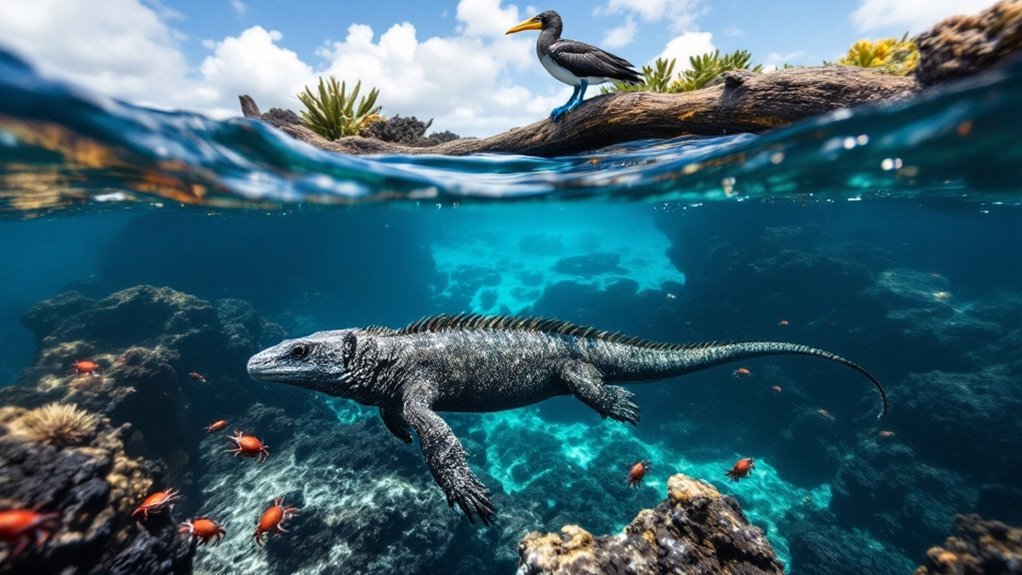
The Galápagos marine domain stands as one of Earth's most extraordinary underwater ecosystems, where converging ocean currents create a biological melting pot.
You'll discover over 500 fish species here, with schools of snappers and barracuda swimming through waters that hold the world's highest fish biomass at 17.5 tons per hectare.
The remarkable diversity comes from seven major currents that converge around these islands.
While snorkeling, you're likely to encounter playful sea lions, reef sharks, and graceful eagle rays.
The islands' unique residents include the marine iguana – Earth's only sea-going lizard – and the northernmost penguin species.
At spots like Fernandina Island, you can watch these remarkable creatures in action.
However, this paradise faces challenges from overfishing, invasive species, and climate change.
Expanded marine protected areas and conservation efforts are working to preserve this underwater wonderland for future generations.
Life in the Galápagos Islands follows two distinct seasonal rhythms that shape wildlife activity and visitor experiences throughout the year.
You'll encounter the warm/wet season from December to May, which brings daily rains and warmer temperatures, while the cool/dry season from June to November features misty fog and cooler waters. The southern trade winds influence these cooler conditions during the dry season.
Each season offers unique wildlife encounters:
The islands' marine life also shifts with the seasons, as nutrient-rich waters during the cool months attract diverse pelagic species, while warmer waters bring excellent visibility for snorkeling.
You will discover that the Galápagos Islands offer an unmatched visual feast for photographers and nature lovers alike. Whether you're capturing volcanic landscapes, swimming with sea lions, or photographing blue-footed boobies, each moment tells a story of evolution and survival. These islands aren't just a destination – they're a living gallery where you will witness nature's most spectacular displays across land and sea.